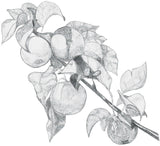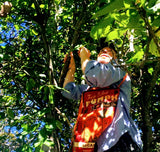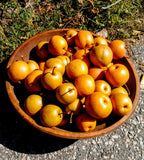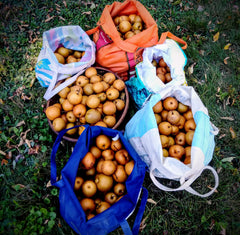
Did you just pay $1.50 for that Asian pear? You are not alone! What you might not realize is that Asian pears are extremely easy to grow, requiring little or no attention once established.
Much fun has been had at the expense of the hapless tomato grower and his $64 Tomato. No doubt, William Alexander's book rings true with many backyard gardeners. Being a tomato enthusiast myself, I've spent many years perfecting the most expensive and time-consuming tomato-growing techniques known to man. While Mike Hoag, at Lillie House, can teach you to grow tomatoes for no money down, I prefer the glorious toil and expense it takes to create truly Epic Tomatoes
.
Keeping a kitchen garden is not for everyone. Many people would rather not be bothered. Even with a no-dig, well-mulched garden, there is always an investment of time and money. Personally, I consider time spent in the garden as therapy, healthy soil being an effective antidepressant, but I get it if that's not your gig. My 2¢ Asian pears, however, are a lot easier than my tomatoes.
So here's the hitch (there's always a hitch, right): you will need to plant your own pear tree(s) to make this math work, and you'll need to stay put for a number of years to let your investment mature. I can advise you on the first part, but the second part's up to you.
Have you ever failed with a fruit tree? I certainly have. Before I perfected my technique, saplings used to cringe in my shadow. Watering newly planted trees is time-consuming and expensive, and I am notoriously forgetful. The good news is watering will be much less necessary if you follow the simple strategy explained below!
 There are several things to consider when planning for 2¢ Asian pears. Foremost is storage potential. To make this math work, you must buy at least one "storage" variety. The Korean Giant (aka Olympic) Asian pear, can reportedly be stored up to 9 months under the right conditions. But some varieties won't last 4 weeks. Other considerations are flavor profile, size of tree (determined by rootstock), and cold-hardiness. Finally, while my math is based on only one tree, you will have a more reliable harvest with two trees that readily cross pollinate. Sometimes a tree will have a lackluster year. A second tree can balance your production. Check out Peaceful Heritage Nursery, or another reputable online seller, for availability & cross-pollination suggestions.
There are several things to consider when planning for 2¢ Asian pears. Foremost is storage potential. To make this math work, you must buy at least one "storage" variety. The Korean Giant (aka Olympic) Asian pear, can reportedly be stored up to 9 months under the right conditions. But some varieties won't last 4 weeks. Other considerations are flavor profile, size of tree (determined by rootstock), and cold-hardiness. Finally, while my math is based on only one tree, you will have a more reliable harvest with two trees that readily cross pollinate. Sometimes a tree will have a lackluster year. A second tree can balance your production. Check out Peaceful Heritage Nursery, or another reputable online seller, for availability & cross-pollination suggestions.
Your year 1 cost, including mulch, should be less than $75. This price does not include the rhododendron, daylilies, five packets of seeds, and the potted palm that you will inevitably add to your shopping cart.
 Once you have your Asian pear tree, plant it according to the nursery's directions. After planting, chop up any compacted soil in a 3-4' radius around the root ball, using a pitchfork or shovel. Water well, and add a layer of soaked cardboard over the disturbed soil. Now apply 6 inches of soaked, hardwood mulch over the cardboard, being careful to leave a ring of shallower mulch around the tree. The scar at the base of the trunk, where the tree was grafted to rootstock, must always be left exposed. After planting, return every few days and stick your finger into the mulch. You will soon realize just how long deep mulch can hold water. In New England, the rain will often be sufficient, but you can soak it again whenever necessary. The mulch will also contribute to your growing tree's health, releasing valuable nutrients over time. There is, arguably, no need for fertilizer if you apply repeated layers of hardwood mulch.
Once you have your Asian pear tree, plant it according to the nursery's directions. After planting, chop up any compacted soil in a 3-4' radius around the root ball, using a pitchfork or shovel. Water well, and add a layer of soaked cardboard over the disturbed soil. Now apply 6 inches of soaked, hardwood mulch over the cardboard, being careful to leave a ring of shallower mulch around the tree. The scar at the base of the trunk, where the tree was grafted to rootstock, must always be left exposed. After planting, return every few days and stick your finger into the mulch. You will soon realize just how long deep mulch can hold water. In New England, the rain will often be sufficient, but you can soak it again whenever necessary. The mulch will also contribute to your growing tree's health, releasing valuable nutrients over time. There is, arguably, no need for fertilizer if you apply repeated layers of hardwood mulch.
If you have deer, voles, or other hungry herbivores, you will need to protect your young trees, especially over the winter. For this, I am no help, as I live in a dense neighborhood with none of the above. You will have to rely on your local extension service for advice about pests.
 In year 2, add another 3" of soaked mulch to your original bed. You may also choose to plant some creeping thyme, rhubarb, and/or beneficial flowers, like comfrey or yarrow, in the wood chips. The mulch should cost less than $25. When buying mulch at the garden center, try to avoid replacing the dead potted palm.
In year 2, add another 3" of soaked mulch to your original bed. You may also choose to plant some creeping thyme, rhubarb, and/or beneficial flowers, like comfrey or yarrow, in the wood chips. The mulch should cost less than $25. When buying mulch at the garden center, try to avoid replacing the dead potted palm.
After year 3, if your tree is healthy and established, mulch is optional except in drought-prone climates. Just keep the soil protected from the sun. Unless you are digging a hole, you should never be able to see bare soil. Even grass will do the trick, but hopefully you'll consider other, more productive, groundcovers. You may begin to see fruit in year 3 and, by year 5, you may be picking enough fruit to store.
 By year 12, a healthy, mature tree can produce 100-400 lbs of fruit per year. Over the span of twenty years, your fruit tree should easily produce at least 3000 lbs of fruit. Assuming a weight of 1/2 lb per pear, and divided by your input of $100, your per-pear cost should be well under 2¢. You can maximize your production with all sorts of tricks, but even the laziest of growers should be able to manage 2¢ pears.
By year 12, a healthy, mature tree can produce 100-400 lbs of fruit per year. Over the span of twenty years, your fruit tree should easily produce at least 3000 lbs of fruit. Assuming a weight of 1/2 lb per pear, and divided by your input of $100, your per-pear cost should be well under 2¢. You can maximize your production with all sorts of tricks, but even the laziest of growers should be able to manage 2¢ pears.
While you'll always find some imperfect fruit, the Asian pear is remarkably resistant to most pome fruit pests and diseases. In fact, in a region notorious for apple and pear diseases, all of the fruit shown here was grown without care.
Asian pears can be canned just like other pears. They can also be juiced, fermented, mashed into sauce or made into vinegar. You can even grow them for wine. With a little creativity, you can be eating and drinking them all year long.
Enjoy!
